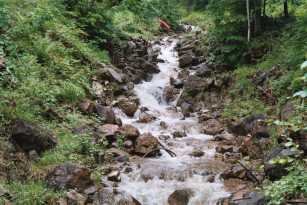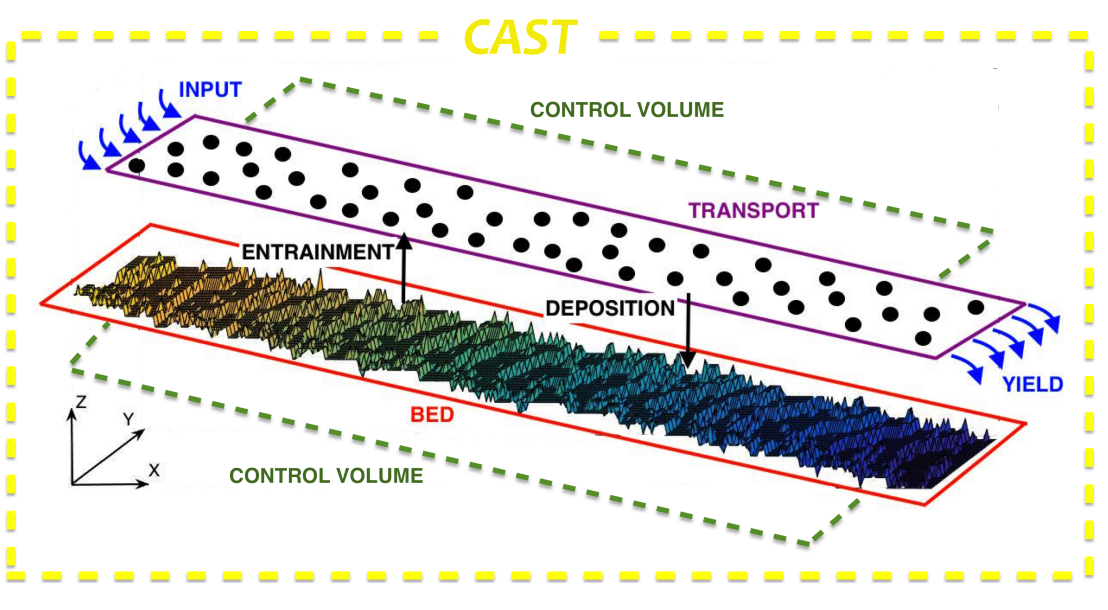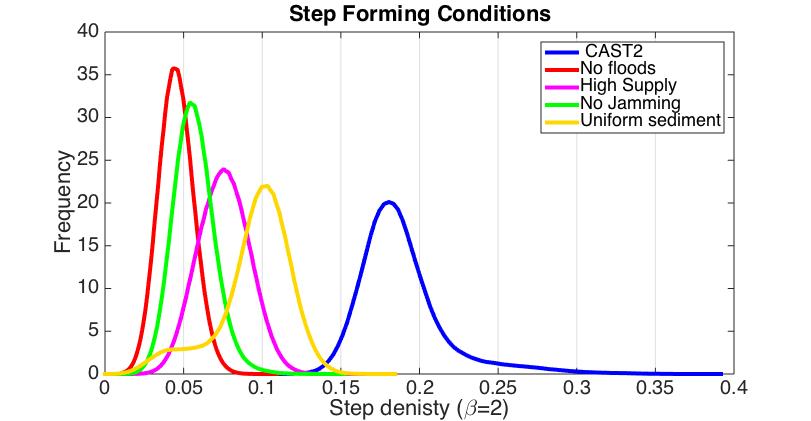STEPsoc - Modelling step formation in steep streams
Dates: 2012-2016
Funding: Swiss National Science Foundation
PhD Student: Matteo Saletti
Dissertation: e-collection
Principal Investigator: Peter Molnar

Step-pool systems in steep mountain streams are self-organizing and self-sustaining structures. The temporary storage of sediment in steps and the release of that sediment in avalanche-like pulses when steps collapse leads to complex nonlinear threshold-driven dynamics in sediment transport. This research project explores the critical state at which steps are formed with the toolbox of self-organized criticality. This is done by means of a reduced-complexity model which was developed in this research. CAST (Cellular Automaton Sediment Transport) is a cellular automaton 2-d model that parametrizes sediment transport by phenomenological grain-grain and grain-bed interaction rules. The modeling framework is tested against laboratory experiments in collaboration with Prof. M. Hassan at UBC (Canada) and field data in the Erlenbach in collaboration with D. Rieckenmann at WSL and J. Turowski at GFZ, Potsdam.
Step-pool channels in the lab

Experimental data on step-pool channels performed at the Lab of Prof. M. Hassan (UBC, Canada) were analyzed to describe the temporal dynamics of sediment transport and its relation of discharge, and memory in grain size-dependent transport. A complex non-unique relation between discharge and sediment transport is observed in data. The strength and nature of memory in sediment transport estimated by the Hurst exponent show the presence of long-term memory which is grain-size dependent, and caused by pulses of coarse grain in transport generated by step collapse and bed adjustment. In this way bed morphology and sediment transport are intrinsically linked.
Saletti, M., P. Molnar, A. Zimmermann, M. A. Hassan, and M. Church (2015), external pageTemporal variability and memory in sediment transport in an experimental step-pool channelcall_made, Water Resour. Res., 51, 9325-9337, doi:10.1002/2015WR016929.
The reduced complexity step model CAST

A new particle-based reduced complexity model CAST (Cellular Automaton Sediment Transport) was developed. It contains phenomenological parameterizations of sediment supply, bed load transport, and particle entrainment/deposition with uniform grain size. The model reproduces a realistic step-pool bed morphology in agreement with field data. A jamming routine in CAST simulates the grain-grain and grain-bed interactions that lead to step formation in unsteady conditions. Steps are shown to be created during high-flow periods and they survive during low flows only in sediment-starved conditions. The modelling approach in CAST gives new insights into the dynamics of grain-based transport and are a useful complement to physically based models.
Saletti, M., P. Molnar, M. A. Hassan, and P. Burlando (2016), external pageA reduced-complexity model for sediment transport and step-pool morphologycall_made, Earth Surf. Dynam., 4, 549-566, doi:10.5194/esurf-4-549-2016.
Flood and jamming effects on steps

A further development in this research is a reduced complexity model for step formation with 2 grain sizes CAST2. With this model we show that the required processes to generate and maintain steps in steep channels are (a) floods which produce time-varying critical entrainment conditions, (b) jamming of keystone grains during transport, (c) low enough sediment transport so that steps are not buried, and (d) non-uniform grains with different entrainment thresholds. Model results are compared with field data from three streams in different step-pool streams. This research highlights the role of hydrological forcing on the geomorphological response of mountain streams.
Saletti, M., P. Molnar, J. Turowski, and D. Rickenmann, The effect of floods and jamming on step formation and stability: insight from a multi-grain reduced-complexity model, in review.
